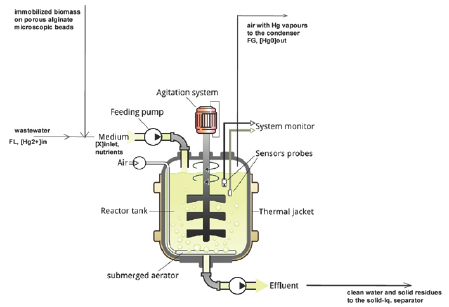Pareto-Optimal Operating Policies of a Three-Phase- Fluidized-Bed Reactor Used for the Oxidation of D-Glucose on Co-Immobilized Pyranose Oxidase and Catalase
Gheorghe Maria* and Mara Cri$an
University Politehnica of Bucharest, Department of Chemical & Biochemical Engineering, Romania
Submission: April 18, 2017; Published: April 26, 2017
*Corresponding author:Gheorghe Maria, University Politehnica of Bucharest, Department of Chemical & Biochemical Engineering, Polizu Str. 1, 011061 Bucharest, P.O. 35-107, Romania, Email: gmaria99m@hotmail.com
How to cite this article: Gheorghe M, Mara C. Pareto-Optimal Operating Policies of a Three-Phase-Fluidized-Bed Reactor Used for the Oxidation of D-Glucose on Co-Immobilized Pyranose Oxidase and Catalase. Curr Trends Biomedical Eng & Biosci. 2017; 3(3): 555611. DOI: 10.19080/CTBEB.2017.03.555611
Abstract
One essential engineering problem when developing an industrial enzymatic process concerns the choice of the reactor operating alternative based on a-priori knowledge of the process kinetics and enzyme inactivation characteristics. For a multi-enzymatic system, involving complex interactions among enzymes that exhibit optimal activity on different parametric domains, with a complex deactivation, this problem requires an extended analysis. The engineering problem becomes difficult when a multi-objective optimization problem is formulated. An elegant option developed in this paper is to obtain sets of Pareto optimal solutions, also called Pareto-optimal fronts, each one generated for the case of at least two adverse objectives. Then, the final choice of the enzymatic reactor operating policy results from the comparative analysis of these fronts. Exemplification is made for the case of the oxidation of D-glucose (DG) to 2-keto-D-glucose (kDG) in the presence of P2Ox (oxygen 2-oxidoreductase, EC 1.1.3.10) and catalase (EC 1.11.16), continuously operated in a three-phase-fluidized- bed reactor (TPFB) with co-immobilized enzymes on alginate beads. Model-based optimal reactor choice is based on the minimum amount of required P2Ox and catalase that ensures an imposed reaction conversion and maximum reactor productivity under various technological constraints, at 30 °C.
Keywords: Mechanically agitated reactor optimization; D-glucose oxidation; Pyranose oxidase; catalase; Pareto-optimal fronts; Optimal operating policies
Introduction
When developing an industrial enzymatic process, one essential engineering problem concerns the choice of the reactor optimal operating policy based on a-priori knowledge of the process kinetics and enzyme inactivation characteristics. For a multi-enzymatic system, involving complex interactions among enzymes that exhibit optimal activity on different parametric domains, and a high-order deactivation, this problem requires an extended analysis. The engineering problem becomes difficult when a multi-objective optimization problem is formulated. An elegant option developed in this paper is to obtain sets of Pareto optimal solutions, also called Pareto-optimal fronts, each one generated for the case of at least two adverse objectives. Then, the final choice of the enzymatic reactor operating policy results from the comparative analysis of these fronts. Exemplification is made for the case of the oxidation of D-glucose (DG) to 2-keto-D- glucose (kDG) in the presence of P2Ox (oxygen 2-oxidoreductase) and catalase, continuously operated in a three-phase-fluidized- bed reactor (TPFB) with co-immobilized enzymes on alginate beads (Figure 1). To perform the TPFB optimization, a dynamic ideal model was adopted from literature [1-3] corresponding to an isothermal, perfectly mixed reactor of constant volume, semi- continuously operated, with vigorous aeration and mechanical stirring, fed with substrate solution, and including suspended solid particles (spherical beads of less than 1-2 mm diameter) with immobilized enzymes. The current model also considers P2Ox activity decay due to their chemical interactions, but also due to its leaking following the hydrodynamic stress, and its inherent denaturation over time [3].


The optimal operating policy choice is that requiring minimum P2Ox amount but ensuring an imposed reaction conversion (more than 30% here, most of the running time), and maximum reactor productivity under various technological constraints (see one of such a Pareto-front in Figure 2. An extended discussion of how to compare and manage such Pareto-fronts is presented in [3]. The result of such a numerical analysis is the best tradeoff optimal operating policy of the TPFB bioreactor.
References
- Maria G (2012) Enzymatic reactor selection and derivation of the optimal operation policy by using a model-based modular simulation platform, Computers & Chemical Engineering 36(1): 325-341.
- Maria G, Crisan M (2015) Evaluation of optimal operation alternatives of reactors used for D-glucose oxidation in a bi-enzymatic system with a complex deactivation kinetics. Asia-Pacific Journal of Chemical Engineering 10: 22-44.
- Maria G, Crisan M (2017) Operation of a mechanically agitated semi- continuous multi-enzymatic reactor by using the Pareto-optimal multiple front method. Journal of Process Control 53: 95-105.

Dr. Gheorghe Maria is currently professor in Chemical & Biochemical Reaction Engineering with the UPB - University Politehnica of Bucharest (Romania). He received the PhD in 1987 in chemical engineering at UPB (supervisor Prof. Dr. ing. Raul Mihail). On 1982 he joined ICECHIM research center in Bucharest (catalysis, and chemical & biochemical energetics Institute, as a senior researcher), and on 1990 he joined UPB as a lecturer. On 1992 he come in Switzerland for working as Assistant Professor with ETH Zurich (with the late Prof. David W.T. Rippin group of Process System Engineering). On 1997 he return to Romania becoming Associate Professor and then full Professor (1999) with UPB. His research interests concern the fields of (bio)chemical reactor and kinetic modelling, biochemical engineering and bioinformatics, risk analysis of chemical plants, modelling of cell metabolic processes, gene expression and regulatory circuits, and drug release kinetics. Over the past 25 years he participated to various national or intl. Projects (more than 15), making short research stages/visitingship at ETH Zurich (3-months on 1997, SNSF fellow), Univ. des Saarlandes (3-months on 1999, DAAD fellow on modelling complex enzymatic kinetics), TU Erlangen (3-months on 2000), Texas A&M University (2002¬2003, research scientist on modelling gene expression and gene regulatory networks, synthetic biology), TU Braunschweig (2006) and TU Hamburg (2009, DFG and DAAD fellows on simulating bacteria resistance to environmental pollutants), Tianjin Inst. Ind. Biotechnology China (2-months on 2010, in-silico searching for gene knockout strategies for E. coli cell, synthetic biology). He presented more than 31 invited Lectures at various Universities in EU, CAN, USA, China (among them: Princeton Univ. 1994, Texas A&M University 2002, EPFL Lausanne 1997, Queen's Univ. Kingston 1994 Canada, BASF Ludwigshafen 1996). He authored 6 books, 5 teaching books, 6 book chapters, 130 papers in peer reviewed ISI international journals and univ. journals, and 77 in intl. conference proceedings, with more than 1036 citations in Googlescholar (h-index 17 and i10 index 37; ResearchGate score = 34.79). Among them, 29 papers have been published in Chem. Eng. journals with the highest IF > 3. According to the Romanian ranking system, he reported high scores signing NP=97 ISI papers as principal author, with a cummultative impact factor of FIC= 135.04, and more than 1039 citations (Googlescholar). He is a reviewer for many (bio)chemical engineering journals (25). He co-chaired or was member of the organizing Committees of 16 international conferences Among them: 5th Int. Conference on Computational Bioengineering (ICCB-5), 11-13 September, 2013, Leuven, Belgium; ROMPHYSCHEM-15, 15-th International Conference of Physical Chemistry, 11-13 September, 2013, Bucharest; 13th Edition of Academic Days of Timisoara, June 13-14, 2013, Timisoara (Romania); ELSEDIMA 10th and 11th International Conference (Environmental Legislation, Safety Engineering and Disaster Management), 18-19 September 2014 and 26-28 May 2016, Cluj-Napoca (RO).
On 1985 he award the Prize of the Romanian Academy for kinetic studies and scalep / plant design of the methanol-to-gasoline process at Brazi petrochemical works. He is member in the scientific/editorial board of Chem. & Biochemical Eng. Q. (Zagreb), Revista de Chimie (Bucharest), The Scientific Bulletin of University POLITEHNICA of Bucharest, Bulletin of Romanian Chemical Engineering Society, ECOTERRA Journal of Environmental Research and Protection (edited by Romanian Society of Environmental Sciences and Engineering, Cluj-Napoca Romania). He was also an expert for various EU and national research programs, being also a PhD supervisor at UPB (from 2008, in Chem. & Biochem. Engineering topics), with 5 PhDs finalized, and 4 PhDs in progress. He participated as researcher or director to a large number of national and international grants. Among them are to be mentioned:
• SNSF Swiss-Romanian Project Project 7IP 050 113 / 1997-1998 on: 'Ecological Design and Operation of Chemical Processes', at ETH Zurich;
• NATO Grant no. 974850-99/1999-2001 on 'Identification, Optimal Monitoring and Risk Limits for a Wastewater Biological Treatment Plants', at Universidade da Porto, Portugal, 1999-2001;
• NIH Project 2002, Department of Chemistry and Biochemistry, Texas A&M University, College Station, USA, on the theme: 'Methodology to construct and simulate molecular-level mechanisms by which living systems grow and divide';
• NIH Project 2002, Texas A&M University, College Station, USA, on 'Kinetics of Programmable Drug Release in Human Plasma';
• DFG Grant SFB-578/2006, Development of biotechnological Processes by Integrating Genetic and Engineering Methods, at TU Braunschweig, Germany;
• National CNCSIS Project nr. 1543/2008-2011 (IDEI) on: 'A nonlinear approach to conceptual design and safe operation of chemical processes' ("O abordare neliniara a problemelor de proiectare conceptuala si de operare in conditii de siguranta a proceselor chimice");
• European Commission Project through European Regional Development Fund and of the Romanian state budget, project P0SCCE-02.1.2-2009-2, ID 691 / 2010-2013, "New mesoporous alumnosilicate matterials for controlled release of biological active substances" (Noi materiale din clasa aluminosilicatilor mezoporosi pentru eliberare controlata de substante biologic active).
• Complete list of publications on his Web-page: https://sites.google.com/site/gheorghemariasite/
• ORCID ID= J-4840-2012
Supplementary information also on:
http://sicr.ro/wp-content/uploads/2017/01/BRChES_2_2016.pdf

Chem. Eng. Mara Crisan received her BSc (2012), and MSc (2014) in Chemical & Biochemical Engineering from University Politehnica of Bucharest (Romania) UPB, being currently a PhD student with the Dept. of Chemical & Biochemical Engineering under the supervision of Prof. Gheorghe MARIA. She is specialized in Bioinformatics (the faculty major in Informatics of chemical and biochemical processes). Even though she is still a young but very ambitious researcher, she co-authored 8 papers in international ISI journals, and presented 6 scientific communications in national or international conference in her research topics (multi-enzymatic reactor optimization). She also co-authored one teaching book (in Romanian), that is:

Maria, G., Crisan, M., Maria, C., Parameter estimation of the (Bio)chemical process kinetic models, Printech publ., Bucharest, 2016 (528 pages), ISBN 978-606-23-0633-5. (in Romanian). Supplementary information also on her ResearchGate page.






























